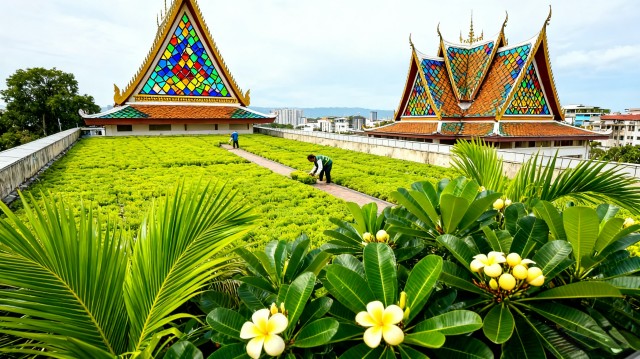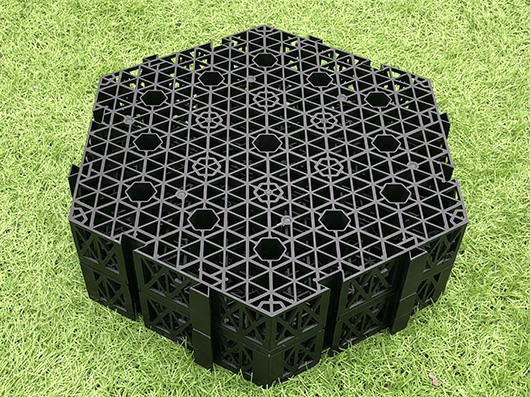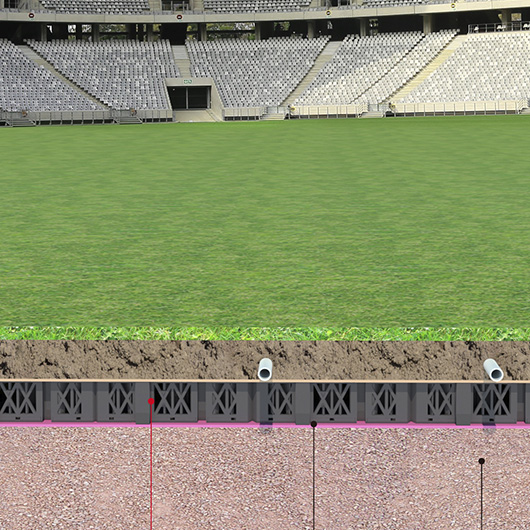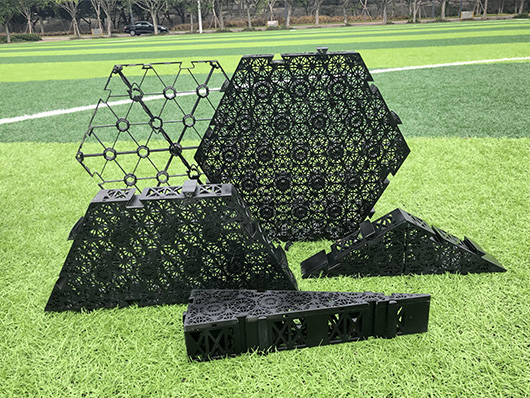HOENSOEY Cells, The Innovative Stormwater Management Modules
2022-10-19
HOENSOEY Cells are the Innovative Ultra-Shallow Geocellular Stormwater Management Storage Modules with Patented Self-interlocking Buckles. It is Hexagonal and has Impressive compressive strength.
If you’re looking for an environmentally friendly way to store water for use during dry periods, you may want to consider HOENSOEY Cells. These ultra-shallow storage units are specifically designed to store water in an environmentally friendly way and can be used in both urban and rural areas.
Not only are they a cost-effective solution, but they’re also very easy to install – so you can get started quickly. In addition, HOENSOEY Cells are backed by a two-year warranty, so you can be sure that you’re getting the best possible product. This revolutionary rainwater storage unit that is currently revolutionizing how we think about water storage.
HOENSOEY Cells not only provide an environmentally sustainable solution to water storage, but they are also incredibly cost-effective. In this article, we’ll take a closer look at HOENSOEY Cells and explore how they can benefit your home or business.
HOENSOEY Cells are a creative component of a robust stormwater management system, capable of greatly reducing the massive negative consequences on shallow groundwater surfaces. In comparison to conventional cells, HOENSOEY Cells require less deep underground excavation due to their shallow profile.
As a result, it contributes significantly to long-term sustainable development. Hexagonal HOENSOEY Cells may better serve on supports due to their hollow construction and high strength. Meanwhile, the HOENSOEY geocellular attenuation tank can collect stormwater.
HOENSOEY stormwater modules, as contemporary, innovative, and ecologically friendly products, contribute significantly to lowering the effects of the “urban heat island effect.” They produce a beautiful natural landscape while also beautifying the urban surroundings.
HOENSOEY Cells Features
HOENSOEY cells are unlike anything you have seen before. The key properties of HOENSOEY cells are as follows:
Impressive compressive strength: Maximum vertical loading; 130 tons per square meter; maximum lateral loading: 40 tons per square meter (data comes from the authoritative testing institute)
Hollow structures: Stormwater modules have a hollowed-out construction on the outside and a solid inside. Water flows between each module without any disturbance. Each module is linked to the next. For the water processing procedure, the void ratio is roughly 95%.
Patented Buckles: Six distinct sets of patented buckles are linked together. Each HOENSOEY Cell is inseparable due to the technique of connecting. More significantly, installation is simple and fast.
Why HOENSOEY Cells Are Hexagonal?
Hoensoey Cells are designed to be hexagonal. But why is that? Well, because it is the most efficient shape there is. Here’s why.
Better Strength: Hoensoey cells can withstand 80 tons/sqm of vertical pressure. And it’s all thanks to the exceptional level of stability provided by the hexagonal shape.
Combinable: We wanted to use a shape that allows the highest level of combinability. One cell had to be easily added to others while keeping minimal gaps. So, after a lot of research and testing, we concluded that the hexagonal shape is the best at this even when creating complex combinations.
Triangles Are Tough: Ask any engineer about what’s the strongest shape and they will say, “triangle”. And hexagons are basically six triangles forming one shape. That’s why the Hoensoey cells are immensely durable considering their weight and density.
Various Systems HOENSOEY Cells
The HOENSOEY cells work in three core systems which enhances its fields of application. Let’s take a look at the three systems where HOENSOEY cells work in:
- Pavement foundation
The LID Sub-base Replacement System may replace several typical granular gradients in the ground’s bottom layer:
- It is utilized in a variety of applications such as permeable pavement, concrete pavement, roads, etc. The void ratio of 95% considerably boosts surface rainfall absorption capacity and decreases the need for bottom aggregates
- Rainwater infiltration occurs in real-time. The technique can make the ground smooth and less prone to sinking by reinforcing the base of the base
- Only 35 cm was dug, significantly reducing building costs and time
- It may be employed in a variety of settings, including roadways, parking lots, garage roofs, and racetracks.
The traffic load may be securely and reliably transmitted to the roadbed because of the ultra-high load performance. The tremendous cost of shipping and placing foundation stones is no longer necessary, preventing basement pollution and efficiently avoiding high water levels.
The shallow drainage system reduces excavation costs. At the same time, it minimizes stormwater flow to achieve the stormwater assessment system’s BMP aim. Because sub-base replacement systems can endure severe traffic loads over an extended length of time, they may be used in place of standard gravel bases to improve road safety and functionality.
When the roadbed’s soil quality is inadequate, the LID sub-base replacement system can be highly beneficial to spread the traffic load without compounding the situation by raising the foundation’s fixed load. When the roadbed’s soil quality is good, sub-base replacement systems can be built to generate a permeable effect and maximize the permeable area.
The technique can turn practically any roadbed into a large stormwater management instrument capable of transporting and storing water.
- Power-free Green System
A powerless irrigation system can cut irrigation expenditures by up to 60% and drainage costs by 30%. Rainwater seeps into the ground and enters the HOENSOEY storm modules via the drainage ditch for temporary storage. It is then carried to the soil layer mechanically by water-wicking strips.
Then the plant roots constantly take water from the soil; the pipes drain surplus water outside. If there is a dearth of water due to a lengthy drought, water sources will be replenished. There are several uses for passive irrigation systems, such as green roof systems, green sections of the ground, buried green spaces, sports grounds, etc.
Various water-saving irrigation techniques in urban areas pose quite a lot of problems. The first problem is the lack of humanization. Sprinklers recklessly spread water on sidewalks and in places where it’s not necessary. Lack of professionalism and mismanagement are two other dire problems. Power-free green roofs aided by HOENSOEY cells can be the key to solving all these problems.
- Trees And Rods Protection
The deep root watering system is intended to safeguard trees and roads. The tree root protection system aids in the transfer of traffic loads from the ground’s surface. Meanwhile, it contributes to road surface protection. It also promotes the notion of low-cost tree upkeep. For starters, the hollow structures in the system serve as water transport channels, delivering rainfall to the tree’s root zone.
Second, the system’s air gaps keep roots from spreading upward and harming roadways and key infrastructure. At the same time, such air holes keep air flowing straight to the root system. You might have seen photographs of roadside roots sprouting from the ground, damaged pavement, and non-vehicle road surfaces.
The once flat road surface has become eroded and uneven. There are bumps and crevasses all along the road. Tree roots on the pavement have fractured several of the floor tiles, causing them to be abandoned. Citizens on bicycles or in automobiles, as well as pedestrians, had to avoid the damaged road surface.
They made every effort to avoid damaged roadways. The roots of the trees lifted the floor tiles, affecting the inhabitants’ movement. If you can’t see, it’s easy to trip over, especially at night. As there is no water beneath the pavement, the tree roots penetrate the road and pavement in search of water. HOENSOEY cells can prevent such problems by acting as a water reservoir below the surface.
Applications Of HOENSOEY Cells
HOENSOEY cells can be used in many areas where you want to collect natural water and use it to minimize extra water usage. Let’s take a look at some of the applications of HOENSOEY cells:
- Road
The road surface drainage system’s ultra-high load performance aids in the safe and reliable transfer of traffic load to the roadbed. The ultra-shallow cladding nullifies the necessity of installing a significant quantity of expensive foundation stones.
Furthermore, this prevents roadbed contamination and excessive groundwater levels. The shallow profile reduces stormwater surface runoff while minimizing excavation expenses.
- Green roof
Rainwater seeps into the ground or enters the HOENSOEY storage tank via the drain for temporary storage. The water in the tank is automatically delivered to the soil layer under normal conditions via unique water-conducting strips.
By this process, plant watering requires no outside intervention. Plants take water from the soil continually allowing an irrigation-free system for plant development.
- Eco landscape
Green lawns and flower beds can add a lot of value and beauty to a property. The HOENSOEY geocellular units’ unrivaled compressive strength stores rainfall at the ground surface. It makes passive irrigation simple and guarantees that plants remain in ideal condition even during drought. The drainage system is an excellent choice for creating a lovely rain garden.
- Courtyard
An efficient rainwater reuse system transfers rainfall efficiently to landscaping strips without using drains or irrigation pipelines. The method transports rainwater straight to the root zone of the landscape. The system actively keeps the water away from evaporative heat sources which save up to 50% on irrigation expenditures.
Because smart irrigation systems are so strong and one-of-a-kind, even the most difficult-to-develop places may keep their natural pre-development rainfall utilization.
- Athletic fields
Athletic Fields Drainage System Yard Drainage System provided by HOENSOEY geocellular soakaway crates maximizes water infiltration and storage, protecting costly artificial turf. It also eliminates the need to dig roads to install water collection pipes, conserving materials and improving stormwater source control. The high-intensity interconnecting devices provide better load distribution.
Conclusion
The beautiful thing about HOENSOEY’s ultra-shallow rainwater storage units is that they save space, money, and the environment. Moreover, these innovative systems are energy-efficient and come with highly secure and sustainable stormwater management.
So, be sure to consider one of their rainwater storage systems when you want to curb your wastage of water and make a difference at the same time! If you have any queries, don’t hesitate to contact us.
PrécédentM2018 Rainwater Modules: High-Strength (Up to 60 Tons/m2) Solutions for Urban Sustainability
ProchainePP rainwater harvesting module: new rainwater harvesting technology to alleviate water crisis
Message















